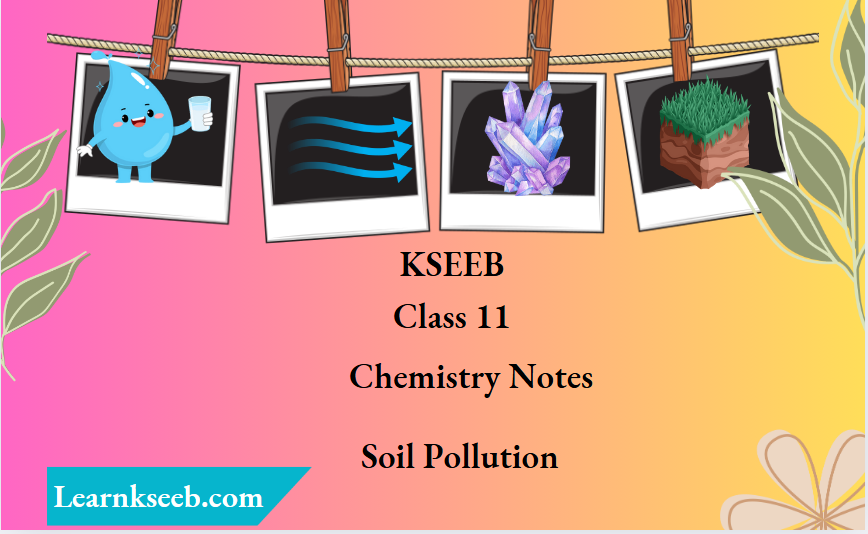KSEEB Class 11 Chemistry Notes For Soil
Soil is a constantly changing mixture of materials composed of organic and inorganic substances water air microorganisms etc., which allows plants to grow. Various kinds of organic and inorganic materials, mixed with ground are extremely difficult. rocks, give rise to the formation of soil.
Chemical Composition Of Soil:
Soil is a complex substance. Its various constituents are:
1. Minerals:
Soil contains different kinds of minerals. The chemical nature of the rock from which the soil originates determines the variety and quantity of minerals in it. The particles present in the soil are basically silicate minerals. The chief constituent elements of soil are silicon, calcium, sodium, potassium, magnesium, iron, aluminium, oxygen etc. These elements are present in the form of silica (SiO2), silicate (KAISi3O8, NaAlSi3O8), epidote [4CaO, 3(AlFe)2O3, 6SiO2, HO2] etc.

Read and Learn More KSEEB Class 11 Chemistry Notes
2. Air:
The particles of soil leave enough space in between, which is occupied by air. The air present in the soil contains carbon dioxide, oxygen, nitrogen and water vapour. But the quantity of O2 present in the soil is less than that of O2 present in air while the quantity of CO2 in the soil is comparatively greater than the corresponding amount in air.
3. Water:
Water content in the soil always varies from place to place. The constitution of soil determines its water tension capacity. If the amount of organic compounds present in the soil is increased then the water-retention capacity of soil will also increase. This water serves as a solvent for mineral and organic matter. Moreover, water retained in the soil plays a vital role in maintaining the structural arrangement of the soil.
4. Organic compounds:
Generally, organic substances are produced from the remnants of dead plant and animal bodies. Besides this, the waste material of living beings is also a potential source of organic substances. The organic matter liberated due to the bacterial decomposition of the remains of plant and animal bodies mix with soil to form humus. This humus is a very significant part of the soil.
KSEEB Class 11 Chemistry Notes On Soil Pollution
Some of its qualitative features are:
- It holds particles of soil in a state of aggregation.
- It increases the water retention capacity of the soil.
- The movement of water and air inside the soil is enhanced by it.
- It serves as a source of food for the microorganisms present in the soil.
Effect of soil on the environment:
- The role of soil in the existence of life is very significant.
- Without soil, the evolution of plants and animals on land would not have been possible. If igneous rocks were heated by the scorching rays of the sun, then the environment would have been inimical to life.
- It is the layer of wet soil that makes the existence of life possible.
- Plants produce organic food by taking the required water and salt;
For example:
Sodium chloride from the soil. The animal kingdom survives by taking this organic food, otherwise, the existence of animal life would have been endangered. So, soil is a component of immense importance for the living world i.e., the flora and fauna
KSEEB Class 11 Chemistry Notes For Soil Pollution
Soil pollution is caused when industrial wastes, radioactive pollutants, domestic and municipal wastes, and agricultural pollutants, are either thrown or dumped into the soil. These reduce the overall quality of soil and are harmful for living beings.
1. Various sources of soil pollution:
1. Pollution caused by industrial waste:
Plastic and paint industries, coal and mining industries, metallurgical units and the industries for the production of sugar, leather, cotton, pesticides, glass, cement etc., discharge a large amount of their discarded waste, which causes soil pollution.
- Moreover, the waste released by thermal and nuclear power plants also pollutes the soil
- Industrial waste containing heavy metals is retained by the soil and these metals, on being absorbed by plants, enter into the human bodies through the food grains and display their toxic effect.
- Industrial effluents such as mercury, lead, zinc, arsenic etc., even destroy many bacteria which are useful for soil.
2. Pollution caused by municipal waste disposal:
Waste material discharged by municipalities
- For example Plastics, accumulated garbage in dust, broken glasses, waste cloth pieces, paper, ash and other discarded materials) are dumped on the roadside or at some particular places.
- These waste materials not only pollute the soil but also act as breeding centres for pathogenic germs.
KSEEB Chemistry Class 11 Soil Pollution
3. Pollution caused by fertiliser:
- Nowadays for agricultural production, chemical fertilisers are widely used. As a result of this indiscriminate use of fertilisers
- The microorganisms which produce humus and nutrients are set to face odds threatening their very existence.
- Use of excessive potassium-containing fertilisers decreases the vitamin-C content (ascorbic acid) in vegetables and fruits, indispensable for our health.
- Due to the application of superphosphate. Assimilation of copper, zinc etc., by the plants becomes very difficult.
4. Pollutionbypesticides:
- The chemical substances used to protect plants from the harmful effects of germs, insects, weeds, fungi etc., are called pesticides.
- Pesticides of various types are used to increase the production of crops. Pesticides are of three types, viz., insecticides, fungicides and herbicides.
The harmful effects of these pesticides are as follows:
- Use of excessive insecticides causes pollution of the soil. Insecticides belonging to the class of organophosphates weaken the muscles of animals. Chlorinated pesticides affect the nervous system and cause stomach cancer.
- Fungicides which destroy fungi are mainly compounds of mercury and copper. Extensive application of these compounds brings about severe soil pollution and disturbs the natural ecosystem.
- Herbicides destroy the unwanted weeds or herbs etc., grown in the soil. When these substances are used in excess amounts, they pollute the soil. In females, these interfere with reproduction and harm the foetus or result in the birth of crippled newborn babies.
5. Pollution caused by acid rain:
- In industrial areas due to air pollution, air becomes enriched with oxides of sulphur and nitrogen (SO2 and NO2 Which ultimately result in acid rain.
- Acid rain increases the acidity of the soil and adversely affects the cultivation of crops.
Pollution caused by radioactive substances:
Radio¬ active waste materials, emitted from atomic reactors, as a result of experimental studies on atom bombs and nuclear experiments, are added to the soil. The radioactive emissions from the waste pollute the whole environment including the land mass.
2. Controls of soil pollution
- Use of sanitary landfills i.e., where untreated waste is buried in layers and covered with earth
- Wastes of glass, plastics, and paper should be recycled for further uses.
- Proper and scientific sanitation in every household is necessary to prevent soil pollution.
- Organic pesticides should be used instead of chemical pesticides.
- Proper afforestation can control soil erosion significantly.
- Proper treatment of industrial effluents can lower the amount of pollutants causing soil pollution.
- Radioactive waste material should be treated cautiously to avoid soil pollution.
